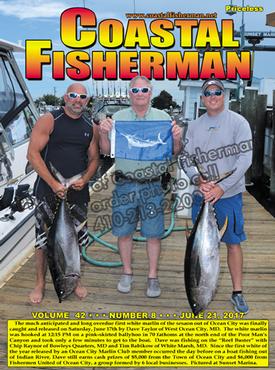


Article by Capt. Steve Katz
 Fuel filtration for gasoline boats
Fuel filtration for gasoline boats
In the last column, we covered the importance of a clean diesel fuel supply to the engine. Now we will cover clean gasoline supply to the engine. Much of our maintenance experience of gasoline engines comes from the automotive world. Automotive fuel filters are not often a subject of discussion, and replacement intervals can be a few years or 30,000 miles or even longer on modern vehicles. When it comes to boats, this interval is greatly reduced for many reasons.
Marine fuel tanks
The built-in marine fuel tank is vented to the atmosphere, usually with a simple hose and vent on the side of the hull. This vent allows air to escape the tank when using fuel and during re-fueling. This vent can also let air into the tank, and since boats are operated on the water, this incoming air is often humid, allowing the eventual accumulation of water into the fuel system.
In a standard marine fuel tank, the pick-up tube (where the engine feed is connected to the tank) reaches down to almost the bottom of the tank. This leaves a small amount of fuel in the bottom of the tank that is unusable, which is a good thing when it comes to contaminants.
This bottom layer may contain dirt, sand and water. Water is heavier than fuel and will settle to the bottom of the tank. Since the pickup doesn't reach the bottom, this bottom layer is along for the ride. On a rough boating day, this bottom layer may get mixed up with the good fuel and is usually filtered out before it gets to the engine.
If the amount of water in the tank becomes excessive, the water can easily enter the engine, unless filtered out by the fuel filters.
The advent of ethanol based fuels, often referred to by their ethanol content, E10 or 10% ethanol, has added new issues to the traditional fuel tank system.
Ethanol fuel
Most gasoline fuel for over the road vehicles now contains some amount of ethanol. This ethanol is used to reduce hydrocarbon emissions. When used in an automobile that is driven on a regular basis, this fuel is not a major maintenance concern, but when ethanol blended fuel is used in a marine environment it can be a concern.
There is one advantage to ethanol fuel mixtures, they have the ability to absorb more water than traditional gasoline fuel. Most engines can easily burn this water-fuel mixture with no ill effects, but once the ethanol fuel can’t absorb any more water, the water settles to the bottom of the tank, just like a pure gasoline fuel.
With ethanol blended fuels, this is where the big problem begins. The excessive water content causes the ethanol to separate or “drop out” of the gasoline, sinking to the bottom of the tank, just above the water in the tank, resulting in three layers, gasoline, ethanol and water. This phase separation in the fuel tank can result in a corrosive mix of ethanol and water, often appearing as a milky white liquid, gel or even power after it has dried. This mixture is most damaging to gasoline engines since it can’t be burned by the engine and it can quickly clog the internal fuel delivery system of the engine, carburetors, pumps, filters and fuel injectors. Additionally, the resulting gasoline layer has a lower octane rating and may not meet your engines specifications. Once this phase separation has occurred, no amount of additives, filtering or treatment can recombine the mixture into good fuel.
To avoid ethanol fuel headaches, many boaters buy fuel at a marina, where non-ethanol fuel is often sold. The use of traditional fuel does not eliminate fuel system maintenance, although it eliminates the possibility of phase separation and alcohol/water contaminants.
Additionally many boaters report longer gasoline “shelf life” with non-ethanol fuels which is very important when storing your boat for extended periods of time.
Filters
Most outboard engines contain at least one internal filter under the cowling. These filters are the last line of defense to prevent contaminants from getting into the engine fuel system. Most of these filters are proprietary to the manufacturer and may require some effort to access and change. These filters are often referred to as secondary fuel filters.
The primary fuel filter is often installed by the boat builder, in-between the fuel tank and engine. This filter is often out in the open or in an easily accessible location to allow quick and easy filter changes. This filter is often referred to a water separating filter, since most are designed to filter out solids and force any water to settle out into the bottom of the filter. Some of these filters contain a clear bowl on the bottom, allowing you to visually inspect the filter to determine if any water exists. While some water in the filter is expected in a marine environment, excessive water is a concern and should be investigated further.
With today’s Ethanol fuel blends, most engine manufacturer recommend a 10 micron rated primary fuel filter. It is not recommended to use a finer filter, since the best way to filter fuel is by using a multistage system, with progressively finer filters downstream of the fuel flow. The typical metal case, spin-on primary fuel filter costs $25 or less and should be changed at least as often as recommended and a spare fuel filter(s) should be carried on-board.
Captain Steve Katz is the owner of Steve’s Marine Service and holds NMEA, AMEI and NMEA2000 certificates along with ABYC Master Technician certification and factory training from many manufacturers.